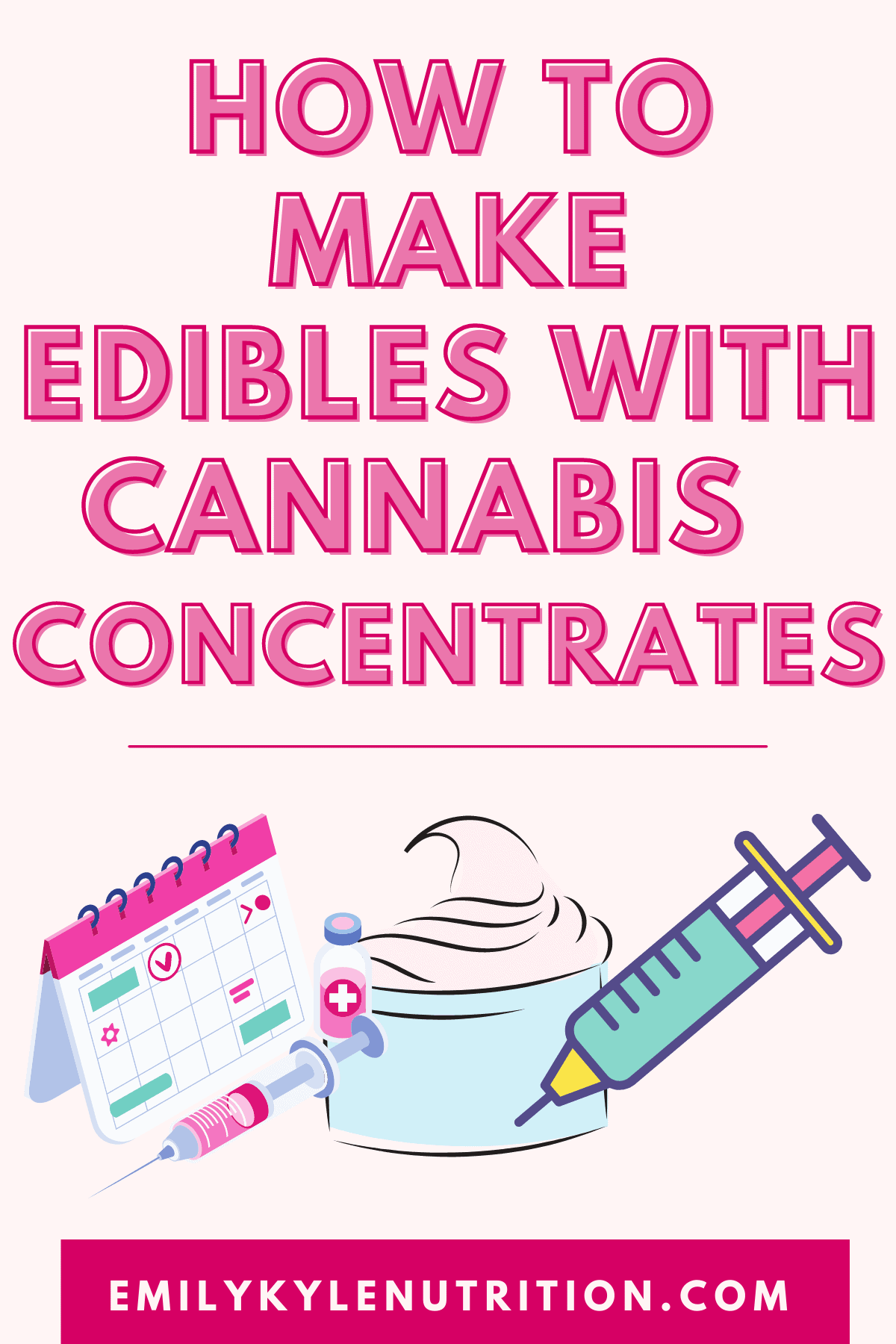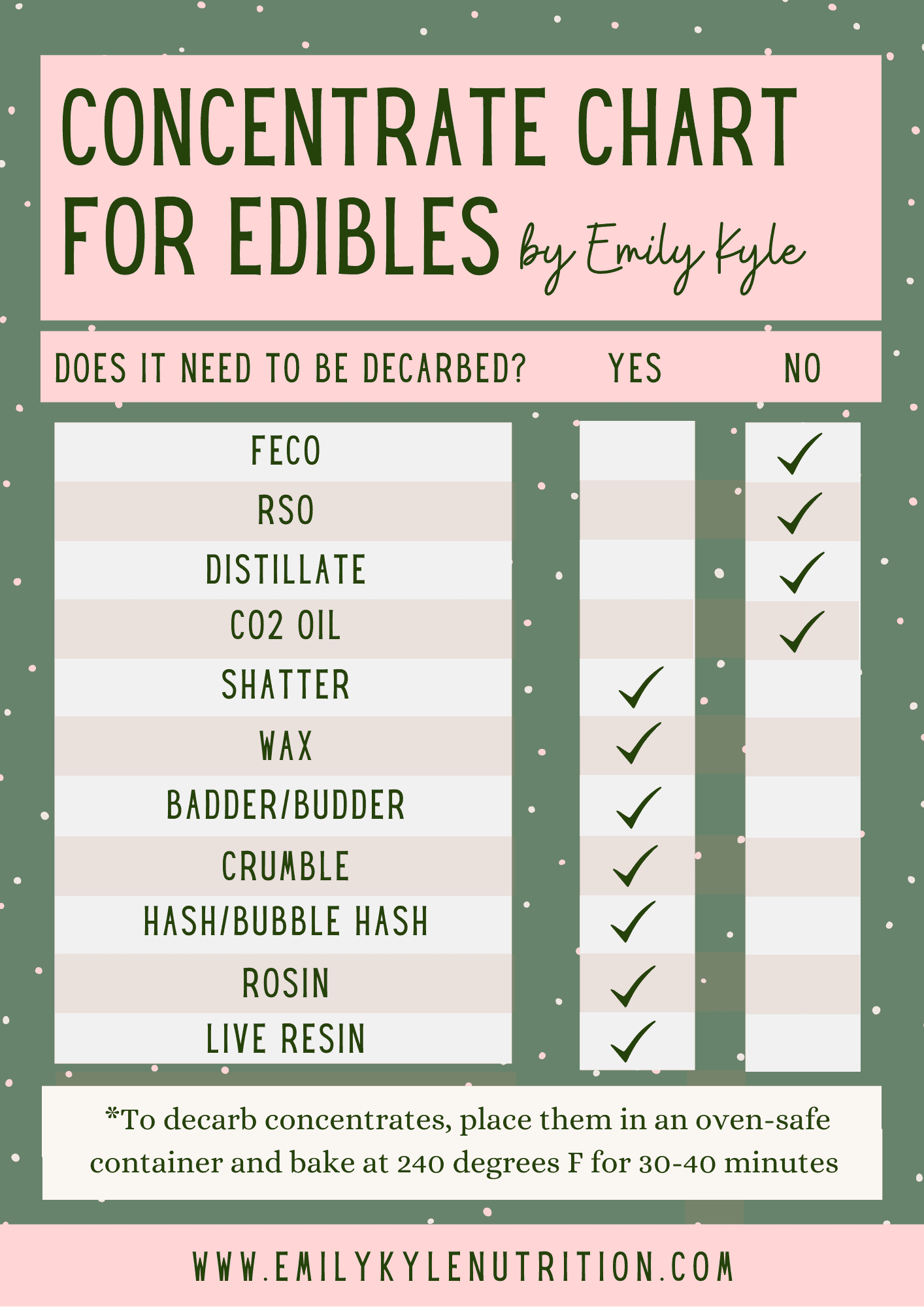Discover everything you need to know about making edibles with cannabis concentrates like shatter, wax, crumble, distillate, FECO, and more, including important notes about safe extraction methods, decarb time and temperatures, and how to incorporate these concentrates into your favorite recipes.

Table of Contents
The Easy Way To Make Edibles
While many people like to make their own oil infusions at home to make edibles, one of the easiest ways to make infused foods is with cannabis concentrates.
Many members of my Well With Cannabis Community agree that they can be the most convenient, easy-to-use, pre-prepared products for cannabis infusions.
Because they are so concentrated, you only need to add a tiny bit to each recipe to get the experience you are looking for.
And because you only need to add a tiny bit, cannabis concentrates will not disrupt your food’s volume, texture, or flavor.
For this reason, cannabis concentrates are very popular among cannabis home cooks.
However, there are a few important things to know before diving into the world of cooking with cannabis concentrates.
With so many different products on the market today, ranging from shatter, wax, crumble, distillate, FECO, and more, it is important to know what product you’re working with and how to use it.
This guide will cover all of these extracts and explore whether they need to be decarbed before infusing into foods and touch on the easiest ways to incorporate them into your favorite cannabis recipes.
What are Concentrates and Extracts?
In today’s growing recreational or medical cannabis market, you can find many products labeled as cannabis concentrates and extracts.
Concentrates and extracts aim to deliver a potent product by isolating the best parts of the cannabis plant, the cannabinoids.
Some of these concentrates and extracts may even be made safely at home.
The range of cannabis products available today is nothing short of astounding, but for an inexperienced user, it can definitely be a bit overwhelming too.
Below we’ll break down a little more about cannabis concentrates and extracts, what they are, what forms they come in, and if they may be the right cannabis product for you.
Before we dive in to find out more, it’s important to know that there is a difference between concentrates and extracts.
What Are Concentrates
Concentrates are a general group of products that contain a concentrated amount of cannabinoids, while extracts are a specific type of concentrate.
Concentrates are just that, a concentration of cannabinoids in a small volume or amount. One example of a common cannabis concentrate is kief.
Kief is made up of the cannabis plant’s resin glands, also known as trichomes, containing much of the plant’s terpenes and cannabinoids.
This means that kief is essentially concentrated cannabis – it’s the most potent part of the plant in terms of cannabinoid concentration.
If you’ve never worked with kief before, you can get my full guide to decarbing and making edibles with kief here.
What Are Extracts
Extracts use solvents to bring out the most desired substances of the cannabis plant. There are many different solvents that can be used to make extracts, but some are safer than others.
I recommend avoiding all extracts made with unsafe solvents such as isopropyl alcohol, naphtha, butane, or other toxic ingredients for health purposes.
The safest and most preferred solvent for making cannabis extracts is high-proof food-grade grain alcohol, or ethanol.
In the same way that vanilla extract is made using alcohol as a solvent to bring out a strong vanilla flavor, cannabis extracts use alcohol to isolate the powerful compounds in the cannabis plant.
Pros and Cons
Before you start using cannabis concentrates, it’s important to understand the pros and cons that you may encounter while using them.
Higher Potency
The first point can be both a positive and a drawback – concentrates are fast-acting and powerful.
This means you only need to use a little to get the desired effect, but it also means it’s easy to go overboard.
These powerful cannabis concentrates are a great option if you’re using the concentrates for certain medical conditions.
Less Cannabis Taste
While some people love the taste of cannabis in their food, others hate it.
For those who are turned off by the taste of the cannabis plant, extracts can be a great alternative.
They have had most of the plant matter removed, resulting in a clean, almost negligible taste.
And if your concentrate does have a slight flavor, because you only need to use a little bit, it’s unlikely you will taste it in your final recipe.
Versatility
But one of the best things about cannabis concentrates is the wide variety of ways they can be used.
You can dab them, vape them, make sublingual supplements, or add them to foods or beverages.
It all depends on your personal preference and preferred consumption method.
Drawbacks
The biggest drawback is that sometimes, it’s difficult to judge the quality of the product your purchase.
Because the cannabis industry is relatively new, there are no regulations about concentrate products, so you’ll definitely find that some are of lower quality than others.
This is why it’s so important to always purchase from a reputable vendor that provides third-party testing for their products.
It is also important to ask the budtender or whoever is working at the dispensary which solvents were used to extract the cannabinoids.
Many of these concerns can be alleviated by making your own cannabis concentrates at home.

Types of Cannabis Concentrates
Concentrates and extracts come in a wide variety of forms.
They are usually classified by the product they were made from, how they were made, and the texture of the resulting product.
You’ll likely encounter a few different terms, so it’s important to know what they mean before you make a purchase.
All of these products can be used in a dab rig, and that is usually the most popular form of consumption.
However, they can be used when making edibles also. It might take a bit of experimentation to find which is right for you.
Each of the terms below refers to the texture and appearance of the concentrates, but each can be made from a variety of strains.
The effects that each produces will often depend on the strain of cannabis used.
Here are a few terms you should know.
FECO
FECO, also known as full-extract cannabis oil, is the one concentrate in this list that can be made at home with a few relatively simple processes.
It starts by making an alcohol extract, known as a cannabis tincture.
Many people choose either a QWET tincture method or a longer-soak Green Dragon tincture method to start.
From there, the cannabinoids are extracted from the plant and suspended in the alcohol.
The alcohol is then safely evaporated off, leaving behind a concentrated black, sticky oil-like substance known as FECO.
You many also see FECO available at your local dispensary. FECO is often used as a sublingual product or in edibles, but it is not recommended to smoke or vape FECO.
RSO
One important thing to note is that many people confuse FECO with RSO – also known as Rick Simpson Oil, or use the terms interchangeably.
Even more frustrating, many dispensaries falsely label their FECO products as RSO.
Both FECO and RSO have the same final characteristics and appear very dark, thick, sticky consistency upon successful completion, and both utilize alcohol as the solvent for extraction.
The main difference between FECO and RSO is the type of alcohol used for the extraction.
FECO utilizes high-proof food-grade grain alcohol, or ethanol, a much safer solvent than the isopropyl alcohol used in the RSO method.
The final outcomes are similar, but isopropyl alcohol (rubbing alcohol, like the kind you would find in your medicine cabinet) IS NOT SAFE TO INGEST.
I DO NOT recommend the RSO extraction method and urge you to talk to your budtender or dispensary manager to clarify which solvent was used to produce the final product.
Distillate
Cannabis distillate is a potent oil extract that contains none of the undesired compounds in the cannabis plant.
It can be up to 99% pure, which means it’s one of the most powerful extracts available.
It appears a golden liquid with very little taste or smell.
Distillates are made through a process called molecular distillation, however, there are many different methods used to get to the final product.
Distillates also go through many refinement processes to help remove all of the unwanted plant matter, leaving behind a highly refined cannabis oil.
During the refinement process, the distillate is usually decarbed, meaning that it is ready to use in cannabis edible as-is, and does not need to undergo a further decarboxylation process.
This is just one reason it is one of the most preferred concentrates on the market today.
Shatter
Shatter is an extract that’s usually brittle and glass-like, varying from translucent golden to amber-colored.
While it is most often used as a dab, or to inhale or vaporize, shatter can be decarbed and used in edibles.
Wax
Wax is an extract that’s softer and more pliable than shatter but has a similar appearance.
While it is most often used as a dab, or to inhale or vaporize, wax can be decarbed and used in edibles.
Badder/Budder
Badder and budder are extracts that are softer in texture than shatter and wax, roughly the texture of a stick of butter or cake batter, and comes in shades of bright yellow and orange.
While it is most often used as a dab, or to inhale or vaporize, it can be decarbed and used in edibles.
Crumble
Crumble is an extract that looks similar to badder/butter, but is drier and more crumbly, as the name suggests.
While it is most often used as a dab, or to inhale or vaporize, it can be decarbed and used in edibles.
Hash (Bubble Hash)
Unlike most of the items on this list, bubble hash isn’t an extract.
It’s made by heating up and pressing the resin glands of the cannabis plant.
This crystalline substance melts easily under heat and pressure and forms into a solid that can be used in a dab rig or in cannabis edibles.
Rosin
The difference between these two concentrates is that resin is an extract, while rosin is a concentrate.
Rosin is the oil expelled from freshly squeezed cannabis plants.
It does not utilize any solvents, rather it relys on heat and pressure to extract the cannabinoids from the plant.
Live rosin is often made as a result of making bubble hash.
Live Resin
Live resin is a cannabis concentrate that is made similarly to rosin, but involves the use of solvents.
Like rosin, resin extraction is usually done with fresh, frozen plant matter.
A frozen solvent is then used to extract the cannabis compounds and create the concentrate.
What Concentrates Need to Be Decarbed for Edibles
If you’re a new cannabis edible consumer, you may not know that eating certain cannabis concentrates without decarbing them first will provide little to no intoxicating effect at all.
This is because raw cannabis flower contains cannabinoid acids, non-intoxicating substances that can convert into the psychoactive substances tetrahydrocannabinol (Δ9-THC) or cannabinol (CBD) through the process of decarboxylation (1).
For making cannabis edibles, most people prefer their concentrates to be decarboxylated into the active forms of THC and CBD.
Ultimately, not all concentrates need to be decarbed before use, some have already been decarbed during the production process.
Use this chart below to determine whether your cannabis concentrate needs to be decarbed prior to using it to make edibles.

How to Incorporate Concentrates into Recipes
By now you should have a good understanding of the different types of cannabis concentrates on the market today.
You should also feel confident knowing that concentrates need to be decarbed, and how to decarb them at home.
From here, it is REALLY easy to add your concentrate to just about anything recipe want.
You just first need to decide how much you want to add, based on your own personal tolerance and preferences.
The incorporate the concentrate into a liquid portion of the recipe, a fat if possible.
This will help more evenly distribute the concentrate through the whole recipe, ensuring there are no clumps that could cause higher dosages in certain spots.
For example, you want to use your cannabis concentrates to bake, gently warm the concentrate and mix it into a little butter or oil.
This will keep the concentrate dispersed throughout the whole recipe.
If you find your concentrate is hard to work with, gently warm it over the stove or in the oven until it is liquid enough to mix in.
Never use a microwave to heat a concentrate as you run the risk of potentially destroying your cannabinoids.

How to Decarb Cannabis Concentrates
Equipment
What You Need
- 1 mL cannabis concentrates
Instructions
- Preheat the oven to 240°F.
- Put the concentrate that needs to be decarbed put into an oven-safe container. A small silicone container like this works great. Do not cover.
- Place the oven-safe container on a baking sheet and place in the oven. Bake at 240°F for 25-30 minutes (for THC) or until it stops bubbling.
- Remove from the oven and allow to cool if desired, or mix directly into butter, oil, or any other fat in a recipe.










Dear Emily,
Everything I know about the process from decarb through consumption I’ve learned from your site so I felt the need to say Thank You for creating such an informative, open, proud cornucopia of valuable information and amazing products (I’m sure.. just purchased revive gummies and roll on). As a forty year veteran I will confidently state that you Emily are the Queen of green. Cannamom… who ever thought??✌️ Be well. Thank you.
Hi David. Your kind words have truly made our day! We’re excited for you to try the Revive Gummies and Roll On. We’ve crafted these products with love and care, so we hope they bring you comfort. Your support means the world to us. We’re always here for any questions or guidance you may need. ☺️
Hi Emily,
Thanks for all your great articles and sharing your knowledge! Can I decarb bubble hash in a crockpot/pressure cooker/ one pot?
Can I use soure turbo.
Hi Verena. With bubble hash, we typically recommend using an oven so you can monitor closely and stir, if needed, to avoid burning. You can decarb in an instant pot/pressure cooker but you aren’t able to keep a close eye on it so you run the risk of overdecarbing, but it can still be done. Let us know what you try. Happy decarbing!
Hi William. The Source Turbo can be a great option for creating cannabis oil or alcohol extractions. It offers a safe and efficient way to make concentrates, allowing you to harness the potency and purity of extracted oils.
Hi,
I have a THC oil I use for this recipe.
Each 1ml contains 30mg Tetrahydrocannabinol in MCT oil.
Net volume of bottle is 50ml.
Flower extract 2000mg, Derived.
From Dried flower 9200mg minimum.
Containing THC 1500mg
Do I need to further infuse this with coconut oil to make up the 1 cup?
When I made this recipe. I added 4ml of the above MCT THC oil to lecithin.
I tested the batch and didn’t notice any effects.
Am i missing something, Did i not ration enough THC / MCT oil?
Thank you,
Jamie
Hi Jamie,
Thanks for reaching out and sharing your experience with the recipe. I’m here to help you figure this out!
Based on the information you’ve shared, it sounds like your THC oil is fairly potent with 30mg of THC per ml. If you added 4ml of this oil to the recipe, that would mean you had a total of 120mg of THC in the entire batch.
The effects of THC can vary greatly from person to person based on factors such as individual tolerance, metabolism, and the amount consumed. It’s possible that the quantity you consumed wasn’t enough to produce noticeable effects for you.
If you didn’t feel any effects, you may want to slightly increase the amount of THC oil in your recipe next time. However, do this cautiously and remember that it can take up to 2 hours or more to feel the full effects of edibles.
As for your question about infusing the THC oil with coconut oil, it’s not necessary unless the recipe specifically calls for it. The MCT oil in your THC oil should suffice as a fat for the THC to bind to.
I hope this helps, Jamie! Remember, the key to a great cannabis-infused dish is patience and careful measurement. If you have any other questions or need further clarification, don’t hesitate to ask. I’m here to assist you!
Hi Emily, I’m curious if I’m able to decarb the live resin in the oven as you indicated and then add right into the butter I plan to bake with? Or do I need to do a second process to infuse my decarbed live resin into the butter?
Hi Secret baker. You can add your decarbed resin directly into the butter you are planning to bake with, but you’re going to want to warm it and mix thoroughly to ensure even distribution of the resin throughout the butter. Happy infusing!